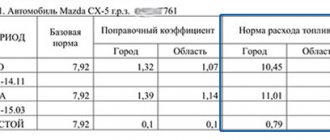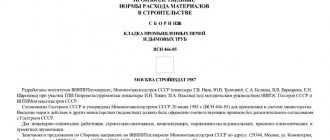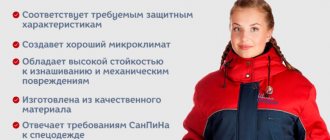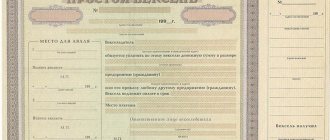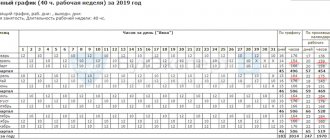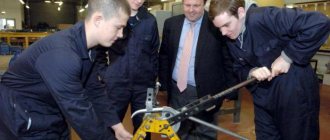The procedure for establishing standards for detergents
Standards for the consumption of detergents and cleaning products are necessary for their effective and rational use.
Any organization sets its own consumption standards for detergents based on the actual need for them. These standards are established by a commission specially created for this purpose, consisting of officials responsible for the sanitary condition of the premises.
When developing standards for detergents, you can be guided by the Order of the Ministry of Health and Social Services. Development of the Russian Federation dated December 17, 2010 No. 1122 no. This document regulates the standards for issuing personal cleaning and disinfection products depending on the type of work performed.
When approving the consumption rates of detergents, it is advisable to use actual data on the consumption of a specific product, technical calculations, as well as the manufacturer’s instructions on the consumption rates of the product.
The nuances of using detergents in healthcare
Enterprises in the healthcare sector can develop consumption standards for detergent compositions independently or according to the recommended volumes of the Ministry of Health, which are given in Order No. 1122n dated December 17, 2010.
In the first case, it is necessary to create an internal commission that will analyze the need for cleaning compositions per year.
Funds are issued not according to a planned schedule, but when an actual need for them arises.
The amount of detergent compositions is determined experimentally - over a given time interval:
- record every fact of cleaning;
- track the consumption of all funds after completing a set of cleaning activities.
Based on the recommendations of the commission, the management of the institution issues an order establishing the consumption rate of detergents for cleaning premises. In the future, all services of the enterprise must adhere to these exact standards when purchasing and issuing cleaning compounds and equipment.
Hospitals and preschool/school education structures also have the right to use their own developments. But when carrying out cleaning, it is advisable for them to comply with legislative standards for the use of special equipment from the mentioned order No. 1122n. This legal act contains the following limits:
- for cleaning compounds;
- disinfectant mixtures;
- flushing liquids;
- cleansers;
- regenerating, restoring, neutralizing agents.
Consumption rates for cleaning detergents
The table shows an example of the consumption standards for cleaning products that the Judicial Department of Russia has developed for itself.
| Product name | Detergent consumption rates in kg per month | |
| Office premises | Industrial premises | |
| Washing powder | 0,5 | 1 |
| Toilet soap | 0,2 | 0,2 |
| Cleaning product for one washbasin, toilet, urinal, bidet | 0,2 | 0,2 |
| Bleaching, chloramine | 0,2 | 0,2 |
| Washing powder for cleaning windows | 0.1 kg per 10 m2 | 0.1 kg per 10 m2 |
| Washing powder for washing elevators | 0,12 | 0,12 |
| Detergent "Second" for elevators | 0,16 | 0,16 |
| Laundry soap | 0,25 | 0,25 |
Rationing of detergents in commerce
All business entities must comply with sanitary and hygienic requirements. But commercial structures are not always strictly tied to legislative expenditure standards. The volume of cleaning costs is mainly influenced by the company's field of activity.
For example, companies operating in public catering are required to adhere to SanPiN 2.3.6.1079-01. This document lists the conditions that employers must provide to staff to perform their job functions. SanPiN also regulates the procedure for actions during basic work processes, including the rules for the use of disinfectants.
| № | Types of flushing and/or neutralizing agents | Name of work and production factors | Issue rate per 1 employee per month |
| I. Protective means | |||
| 1 | Hydrophilic agents (moisture-absorbing, skin moisturizing) | Work with organic solvents, technical oils, lubricants, soot, varnishes and paints, resins, oil and petroleum products, graphite, various types of industrial dust (including coal, metal, glass, paper and others), fuel oil, fiberglass, lubricants oil-based liquids (hereinafter referred to as coolants) and other water-insoluble materials and substances | 100 ml |
| 2 | Hydrophobic agents (moisture repellent, drying skin) | Work with aqueous solutions, water (provided for by the technology), water-based coolants, disinfectants, solutions of cement, lime, acids, alkalis, salts, alkali-oil emulsions and other water-soluble materials and substances; work performed in rubber gloves or gloves made of polymer materials (without natural lining), closed safety shoes | 100 ml |
| 3 | Combined action agents | Work under alternating exposure to water-soluble and water-insoluble materials and substances specified in paragraphs 1 and 2 of the Standard Standards | 100 ml |
| 4 | Products to protect the skin from negative environmental influences (from irritation and skin damage) | External, welding and other work associated with exposure to ultraviolet radiation in ranges A, B, C or exposure to low temperatures and wind | 100 ml |
| 5 | Means for protection against bacteriological harmful factors (disinfectants) | Work with bacterially hazardous environments; when the workplace is located remotely from stationary sanitary facilities; work performed in closed special shoes; with increased requirements for hand sterility in production | 100 ml |
| 6 | Means for protection against biological harmful factors (from arthropod bites) | External work (seasonal, at temperatures above 0° Celsius) during the period of activity of blood-sucking and stinging insects and arachnids | 200 ml |
| II. Cleansers | |||
| 7 | Soap or liquid detergents including: | Work related to easily washed off contaminants | |
| for washing hands | 200 g (toilet soap) or 250 ml (liquid detergents in dispensing devices) | ||
| for body wash | 300 g (toilet soap) or 500 ml (liquid detergents in dispensing devices) | ||
| 8 | Solid toilet soap or liquid detergents | Work involving hard-to-remove, persistent contaminants: oils, lubricants, petroleum products, varnishes, paints, resins, adhesives, bitumen, fuel oil, silicone, soot, graphite, various types of industrial dust (including coal, metal) | 300 g (toilet soap) or 500 ml (liquid detergents in dispensing devices) |
| Work in coal (shale) mines, in open-cast mines, in processing and briquette factories, in mine construction and mine installation organizations in the coal industry | 800 g (toilet soap) or 750 ml (liquid detergents in dispensing devices) | ||
| 9 | Cleansing creams, gels and pastes | Work involving hard-to-remove, persistent contaminants: oils, lubricants, petroleum products, varnishes, paints, resins, adhesives, bitumen, fuel oil, silicone, soot, graphite, various types of industrial dust (including coal, metal) | 200 ml |
| III. Regenerating, restorative agents | |||
| 10 | Regenerating, restorative creams, emulsions | Work with organic solvents, technical oils, lubricants, soot, varnishes and paints, resins, petroleum and petroleum products, graphite, various types of industrial dust (including coal, glass and others), fuel oil, water- and oil-based coolants, with water and aqueous solutions (provided for by the technology), disinfectants, solutions of cement, lime, acids, alkalis, salts, alkali-oil emulsions and other working materials; work performed in rubber gloves or gloves made of polymer materials (without natural lining); negative impact of the environment | 100 ml |
An example of detergent consumption rates in one of the hotels
In order to determine the approximate consumption, you can use the table below.
| Product name | Norm per month |
| Products for ceramics, porcelain, glazed surfaces | |
| “Etalon”, “Duckling”, “Silit”, “Domestos”, etc. | 2.457 ml per 1 m2 of bathroom area, 775-802 ml for one washbasin, toilet, 1240 ml per bath, 915 ml per bidet, 509 ml per urinal |
| "White" | 4.832 ml per 1 m2 of bathroom area |
| "Pemolux", "Chance", "Oxybor" | 2.005 g per 1 m2 of area of ordinary floors or bathrooms, 410 g per toilet, washbasin or tray, 953 g per bath |
| Soda Ash | 60 g per 1 m2 of floor area or bathrooms |
| Bleaching powder | 36 g for washing 1 m2 of bathroom floors, 21 g per washbasin, toilet, tray, urinal, 210 g per bath, 32 g per bidet |
| Consumption rates for soaps and detergents for universal use | |
| Washing powder | 4.946 g for washing 1 m2 of floors and bathrooms |
| Laundry soap | 0.72 g for washing 1 m2 of painted parts of windows, doors, walls, floors |
| Products “Ideal”, “Pemoxol” | 2.005 g for washing 1 m2 of floors and bathrooms, 410 g per washbasin, tray, 953 g per bath |
| Products “Pearl”, “Progress” | 2.873 ml for washing 1 m2 of painted parts of windows, doors, walls, floors |
| Specialized cleaning products | |
| Pipe cleaner "Mole" | 200 ml for one washbasin, bathtub, bidet, tray, 300 ml per toilet |
| Anti-scale agent "Sigma" | 800 ml per electric kettle |
| Dish detergent “Viksan”, “Mila” | 0.7 ml for washing one piece of dishes, 2.82 ml for cleaning one refrigerator |
| Anti-scale agent for washing machines "Kalgon" | 37 g for washing 1 kg of laundry |
| Carpet products | |
| "Carpet", "Carpet Cleaner" | 400 ml per 1 m2 for manual cleaning, 48 ml per 1 m2 for machine cleaning |
| "Bingola Carpet" | 30 ml per 1 m2 |
| Products for mirrors, glass, crystal, windows | |
| “Bingosil”, “Second”, “Blink”, | 1.94 ml per 1 m2 of glass surfaces and mirrors, 1.68 ml for washing 1 m2 of window glass |
What are detergent consumption standards used for?
Certain areas of activity require the need to establish standards for the consumption of materials. Material reserves include assets with a useful life of less than one year. Consumption rates allow you to determine the amount of detergents and cleaning products needed to maintain premises in proper condition. Due to the fact that the acquisition of material reserves of public sector organizations is mostly carried out at the expense of budget funds, established expenditure standards must be observed.
Budgetary organizations, which include healthcare institutions, school and preschool education and other socially significant facilities, are required to adhere to certain rules in matters of order and cleanliness.
In order to organize a mechanism for writing off cleaning products and detergents, the organization needs to establish standards for writing off detergents in budgetary institutions.
The immediate write-off procedure can be presented in two ways: based on the actual costs of purchasing a unit of supplies or based on the average cost.
Documenting
After the commission has worked to determine the standards for each product, the organization issues an order on the consumption rates of detergents indicating specific figures for specific types of products.
The norm for the product is indicated in milliliters if it is a liquid or gel. If the product is powdery or solid, then the norm for it is set in grams. It is also necessary to indicate for what scope of work this standard is established. This could be 1 m2 of floor or window glass, one piece of plumbing (toilet, bathtub, etc.), the number of dishes.
The second option for the consumption rates of detergents for cleaning is a specific amount of detergents for a certain time period, for example, a week, a month, several months.
How much detergent to add: specific numbers
The highest consumption rates are allowed, naturally, when cleaning bathrooms. The calculation is based on the following: 40 ml of liquid or gel detergent per 10 square meters of tile floor. For such an area of a tiled wall – 25-30 ml. To clean and disinfect one standard bathtub you will need 30 ml of detergent; one standard shell – 10-15 ml.
Of course, the highest consumption rate of detergent-disinfectant is provided for the toilet - 40 ml per unit of this plumbing fixture (i.e., the same as for 10 m2 of tiled floor). As for regular washing of floors in production, service and household premises, as well as wet cleaning of furniture, these procedures will require no more than 10-20 ml of detergent for every 10 square meters. What detergents do you mean? For example, the same “Domestos”, or any similar modern preparation of liquid or gel-like consistency.
Principles for determining standards for detergents for kindergartens and schools
Just as in all organizations, standards for the consumption of detergents in budgetary institutions are independently developed and approved by them.
The legislation does not provide specific standards in this area. It defines only specific requirements for the cleanliness and sanitary condition of premises and objects of use. What and in what quantity to use is determined by the garden or school itself, the main thing is that it is clean.
On the other hand, budgetary organizations use budget funds. Therefore, expenses must be rational and economical. And when establishing standards for the consumption of detergents for cleaning premises, bathrooms and other purposes, they must be as effective as possible, but also quite economical.
Standards for consumption of detergents in budgetary institutions
When it comes to organizations that finance expenses from the state budget, special attention is paid to the justification of each purchase. Therefore, more thorough market research and compliance with regulations is required. Every ruble should be spent rationally, and the selected products should be effective and economical.
There are no special requirements for such organizations at the legal level. A fixed amount of funds is allocated for household chemicals. At the same time, they put forward strict requirements for personal hygiene of personnel and the sanitary condition of office and production premises. The calculations are based on this.
For ease of calculation, we present an excerpt from the standard.
Detergents for kindergartens
The main detergents for kindergartens are products for washing floors, plumbing fixtures, dishes, toys, cleaning the catering area and washing bed linen.
An example of the consumption standards for detergents in a kindergarten can be seen in the following table. One of the Russian kindergartens approved such nomes for itself.
| Product name | Consumption rate per group of pupils |
| Carpet cleaner | 3 packs in year |
| Laundry soap 170-200 g | 2 pcs. per month |
| Disinfectant "Domestos", 1 l | 1 pack per month |
| Floor cleaner "Glorix", 1 l | 1 pack per month |
| Glass cleaner “Mr. Muscle”, 0.5 l | 1 pack per month |
| Plumbing product “Sanox”, “Sanitary”, etc., 0.75 l | 1 pack for 2 months |
| Powdered cleaning agent “Pemolux”, 400 g | 1 pack per month |
| Liquid soap for children, 300 ml | 12 packs per month |
| Liquid dishwashing liquid, 500 ml | 4 packs per month |
Standards for issuing detergents in kindergarten
The calculation principle remains the same. The specification is developed by a commission and approved by the management of the institution. It traditionally includes tools for solving the following problems:
- Washing floors.
- Disinfection of toys
- Antibacterial treatment of sinks and toilets.
- Washing bed linen.
- Washing dishes.
- Carpet cleaning.
- Glass washing.
The assortment is selected taking into account the high antibacterial requirements that children's rooms must meet. At the same time, preference is given to not the most aggressive compositions. After all, they can lead to irritation on delicate skin and allergic reactions. If the budget allows, they give preference to products with natural ingredients.
Standards for cleaning products in schools
As for schools, they require approximately the same cleaning products as kindergartens. Standards for the consumption of detergents in schools are also approved individually by the institution itself.
When cleaning educational institutions, detergents are used for floors, toilets and washbasins, windows, walls, doors, furniture, and equipment. There should also be soap on the washbasins.
Problems of rationing costs for detergents
Cleaning and detergent compositions are included in the inventory group in accounting. Their service life is limited to one calendar year.
The use of a rationing system for such consumables allows for rational use of available resources. This is especially true for the budget sector, where every ruble must be accounted for in advance and reserved for a specific enterprise for all cost items. Therefore, first of all, standards for writing off detergents in budgetary institutions have been established (see table at the end of the article).
To create an effective mechanism for ordering and writing off detergents, it is necessary to calculate their need. When determining the total need for cleaning compounds, the planning department is guided by sanitary and hygienic standards for work in a given area.
Increased requirements for cleanliness are imposed on institutions in the educational and medical fields.
The write-off algorithm can be implemented using 2 methods:
- according to the actual costs incurred per unit of stock of such funds;
- according to the average cost of material resources used in cleaning the premises and territory of the organization.
Harm and benefits of detergents
Many of us know that household chemicals and a variety of effective detergents, powders, and gels are harmful to the health of people and especially children.
Before purchasing a new bottle or package, read the ingredients of this product.
Chlorine is harmful and negatively affects hair, skin and nails. It can also cause heart muscle disease, high blood pressure, allergies and asthma.
Chlorine is commonly found in bleach.
Phosphates also have harmful effects on human health. May cause allergies and asthma. They are found in large quantities in washing powders.
Surfactants can damage internal organs, the brain, and weaken the immune system. They are also found in laundry detergents and dishwashing detergents.
What is the optimal percentage of active substances?
Significantly concentrated preparations will allow you to save a lot of money. But there is also a drawback: when using them, more caustic fumes enter the air. A professional product for cleaning and disinfecting large industrial premises, in any case, is stronger than a household product in terms of concentration and larger in terms of packaging container capacity.
The most concentrated detergents are used in food industry workshops and medical institutions, where, naturally, the strictest sanitary rules are in place. But the products used in public catering establishments and hotels should be less concentrated, easy to wash off and erode. In addition, products intended for manual rather than mechanized cleaning (poured into scrubber-drying units) must contain special defoaming substances.
Specific consumption rates for cleaning and disinfection of premises are calculated based on the fact that the phosphate content should be within 10%, and the content of surfactants (PVA) should be within 5%. A good example of such a cleaning and disinfectant is the well-known Domestos. It is made in the form of a fairly thick gel, which prevents caustic substances from entering the air.
Modern natural detergents
Today the market offers ecological detergents that contain components of organic origin. They are not harmful to human health and cope well with the tasks of cleaning, washing and cleaning.
Naturally, the cost of such natural products will be higher than synthetic ones. If the organization is not on a budget and does not pursue the goal of saving on everything, then the use of natural cleaning products can serve it well.
So, for example, private educational or medical institutions, using natural detergents, can position themselves in such a way that they approach the health and safety of their clients or students with care and love.
Office cleaning. We write off detergents and other consumables
The office, of course, is not a dusty production facility. But you should also take care of cleanliness within its walls. Especially during the period of coronavirus infection. Moreover, cleaning is an event provided for by regulations on labor protection and sanitary standards. This means that the organization is simply obliged to keep all premises clean <*>.
In addition, an office, as a rule, is a “computerized” area, and in rooms equipped with a PC, daily wet cleaning should be carried out <*>.
So, taking into account these regulatory requirements, the costs of office cleaning during business activities will be mandatory for the organization and associated with this activity.
You can clean office premises on your own, without the involvement of cleaning companies. To do this, you need to have an appropriate employee on staff and purchase the necessary supplies (materials and equipment: detergents (cleaning agents), rags, mops, brooms, buckets, brushes, cleaning carts, etc.).
Note: The legislation does not provide any lists of detergents (cleaning agents) or other cleaning consumables, nor does it establish standards for their consumption. In this regard, these points are determined by the organization itself (based on its needs and financial capabilities) and, if necessary, recorded (for example, in the Regulations on labor protection at the enterprise or in the relevant order).
Purchased cleaning products and items are taken into account on account 10: some as part of inventory and household supplies (cleaning carts, mops, etc.), something as part of ordinary materials (detergents (cleaning) agents, napkins, rags , garbage bags) <*>.
The procedure for writing off such assets depends, firstly, on which of the named types the organization classified them as (inventory and household supplies or ordinary materials), and secondly, on the provisions of the accounting policy.
If purchases are recognized as materials, they are written off <*>:
— either on the date of issue from the warehouse;
- or based on the fact of use.
Usually the first option is fixed in the accounting policy.
If purchases are regarded as inventory and household supplies, they can be written off at the time and in the amount specified in the accounting policy <*>:
— 100% of the cost — upon transfer from the warehouse to operation;
- 100% of the cost - upon disposal due to unsuitability;
- 50% of the cost - upon transfer to operation, 50% - upon write-off (or in another ratio, for example: 20 and 80, 70 and 30);
- in another way developed by the organization.
But usually organizations choose and record in their accounting policies the first option, i.e. 100% write-off of cost upon commissioning.
When writing off, a posting is made for the required amount: D-t of expense accounts - K-t 10. The debit of the account depends on which office premises are being cleaned. So, they use: count 26 - if they are cleaning the factory administration; count 25 - if, say, they remove an office that manages only the structural divisions of the organization’s main and auxiliary production; count 44 - if we are talking about cleaning the office of a trade organization <*>.
about documenting the write-off of cleaning funds and items .
Dishwashing detergent market
Each housewife has her own specific product with which she is satisfied, and she takes it without hesitation.
AOC is a synthetic detergent. Housewives speak of it as very economical and efficient. Cope with fat even in cold water. Does not cause dry hands.
Frosch is presented on the market as a natural product based on surfactants of natural origin. It foams a little worse than the first product, but does the job well.
Fairy is the most powerful dish soap. Removes grease better than anyone else. It washes off dishes worse than AOS, and it has less foam. It also dries out the skin on your hands a little.
Organic people is positioned as a completely natural product. But it also costs 2-3 times more than previous products. Designed for ordinary stains; it will not cope with heavily burnt dishes. Can be used for washing children's toys and household items. It has a convenient dispenser, the same as in jars of liquid soap.
"Eared nanny" contains a reduced level of surfactants. Does not contain dyes, the smell is not strong. Excellent for removing grease.
Sorti is the cheapest dishwashing detergent available. Cleans well and doesn't dry out your hands. More liquid compared to the previous ones.
Legislative regulation
In addition to Art. 221 of the Labor Code of the Russian Federation, an important document regulating the issuance of detergents is the order of the Ministry of Health dated December 17, 2010 No. 1122n. The standards for issuing flushing and neutralizing agents, as well as their list, are set out in Appendix No. 1 to it.
The employer can set its own standards for issuing soap and similar products, taking into account its capabilities. The standards may be specified in the employment contract with the employee or in the local regulations of the business entity. Employees must be familiar with the information against signature. This is stated in clause 9 of the labor safety standard, approved. by the above order (Appendix No. 2). The standard also explains how to organize the distribution of soap to staff in a company.
Washing powder market
Sarma active has a low cost. It is used economically and effectively copes with various contaminants. But it has a rather aggressive composition.
Ariel removes stains well and is used economically. It costs above average and can cause allergies.
Frosch is positioned as a powder made from natural ingredients. It washes well and is economical. But it costs more than its competitors.
“Eared nanny” has a rather aggressive chemical composition; it cannot be called baby powder. But it copes with dirt perfectly. Packaging in different volumes.
Bimax removes very complex and persistent stains. It's not cheap.
What should be in the order
Traditionally, the order is issued as follows:
- At the beginning, you need to indicate the name of the business entity and its details. As a rule, such documentation is drawn up on company letterhead, so this information will already be there.
- Next, indicate the name of the document, the date and place of its creation, and its essence.
- Then comes the administrative part. It states which of the employees and in what quantity should be given detergents. You also need to refer to regulations, in this case it is Art. 221 Labor Code of the Russian Federation. In addition, it should be noted which employee is responsible for executing the order.
- The document is completed by the signatures of the head of the company and the responsible persons named in the order.
A selection of popular toilet cleaning products
Cillit Bang removes lime and rust from the surface of the toilet well and is economical. It's quite expensive.
Domestos has a gel structure and removes dirt well. But it has an unpleasant chlorine smell.
“Comet 7 days of cleanliness” removes dirt well and is inexpensive. But it has a pungent smell.
“Toilet duck” copes well with dirt, low cost, high consumption.
Sanfor is inexpensive and can be used for cleaning floors and tiles. It has a strong smell of chlorine and does not cope with old stains.
What are they based on?
Specific standards for the consumption of detergents, cleaning products, as well as other equipment in production premises can be determined privately and recorded in a separate order for the enterprise. They are calculated based on the fact that the percentage of phosphates should not exceed ten, and PVA (surfactants) should not exceed five percent.
An example of such a product is Domestos, which is recognized as the most optimal among cleaning gels from an environmental point of view. The consumption standards for detergents in budgetary institutions, approved by order of the director, contain a list of used items indicating the amount of substance required at a particular work site.
Bath and sink cleaners
Cillit Bang can be used both for the bathtub and for tiles, floors, and toilets. Its composition is quite aggressive; you need to work with it with gloves. Effectively removes rust and lime. Has an unpleasant smell.
"Buggy Aktilan" is suitable for washing acrylic and enamel bathtubs, tiles, and toilets. Acts quickly and effectively. But it is quite expensive and has an unpleasant smell.
Frosch consists of natural ingredients, cleans well, and has a very pleasant and fresh aroma. But it does not cope with severe pollution and is expensive.
Cif has the ability to whiten the bathtub, affordable price level. But it does not cope with persistent limescale stains.
"Sanox gel" copes with the most difficult stains. It is quite cheap, but if used frequently it can damage the surface of the bathtub.
About the order
The legislation does not stipulate that such an order must be drawn up. However, in large companies, for better control, it can be issued additionally. Employees do not have to sign for such an order, because they do this on a special personal card when receiving detergents. It is discussed in paragraph 24 of the above standard. The employee responsible for issuing soap must sign as a sign that he is familiar with the order.
What means are we talking about?
In general, consumption rates for detergents and cleaning products are determined for a specific enterprise based on typical data and depend on the size of the area and the number of employees. As a rule, the amount of soap consumed (laundry and toilet), washing powder, polish, cleaning gels, as well as the number of buckets, brushes, cleaning cloths, brushes and other consumables are regulated.
So, in order to clean an industrial premises, the area of which is about 400 m², you need to stock up on washing powder (1 kg), toilet soap (0.2 kg), as well as laundry soap (0.4 kg), and brooms (2 pcs.). This amount is for one month. A floor brush is given to the cleaning lady for two months, a dustpan - for six months, rubber gloves - a pair per month, etc.
Where should an accountant look?
Section 6 of SanPiN (consumption standards for detergents are contained there) is devoted to the write-off (consumption) of necessary preparations for cleaning and disinfection.
According to it, a certain amount of SMS is planned and purchased, which is then distributed among groups for cleaning office offices and premises, laundry, and food service. You can independently make the necessary calculations by identifying the actual average consumption for a specific period. This number will become the basis for calculating the norms.
For convenience, it is better to determine them not by the number of square meters, but by “tying them” to a specific period of time - a week, a month, etc. Moreover, for each business unit (laundry, kitchen, etc.) the data should be calculated separately.
Accounting issues
SMS, like any inventory, should be written off according to existing standards, regardless of what form of ownership the enterprise or institution belongs to.
Each institution deals with the settlement of this issue separately. The accounting policy of the organization or the order of management may adopt its own data. In this case, the specifics of the main activity are always taken into account. Of course, the rate of consumption of detergents in a school will be completely different from that in an industrial workshop.
When writing off, it is always necessary to focus on the observed sanitary regime in accordance with Government Decree No. 1684, adopted on December 30, 2011 and called sanitary rules. This document, containing 11 different sections, regulates the conditions in which children and adolescents should be kept and raised in educational and preschool educational institutions.
Specific numbers
When cleaning premises, staff spend the most drugs, of course, in the bathroom. On average, the consumption rates of detergents and disinfectants for each of the bathrooms per month can be calculated as follows:
• The consumption of liquid product for every 10 m² of tiled floor will be 40 ml.
• On a tiled wall of the same area – 30 ml.
• To clean one bath, you will need 30 ml of detergent and 6 ml of disinfectant. If we take Domestos, then this universal gel performs both functions at once.
• The consumption standards for detergents for cleaning the sink also contain detergent and disinfectant in quantities of 15 and 4 ml, respectively. If you replace them with Domestos, you can get by with just 10 milliliters.
